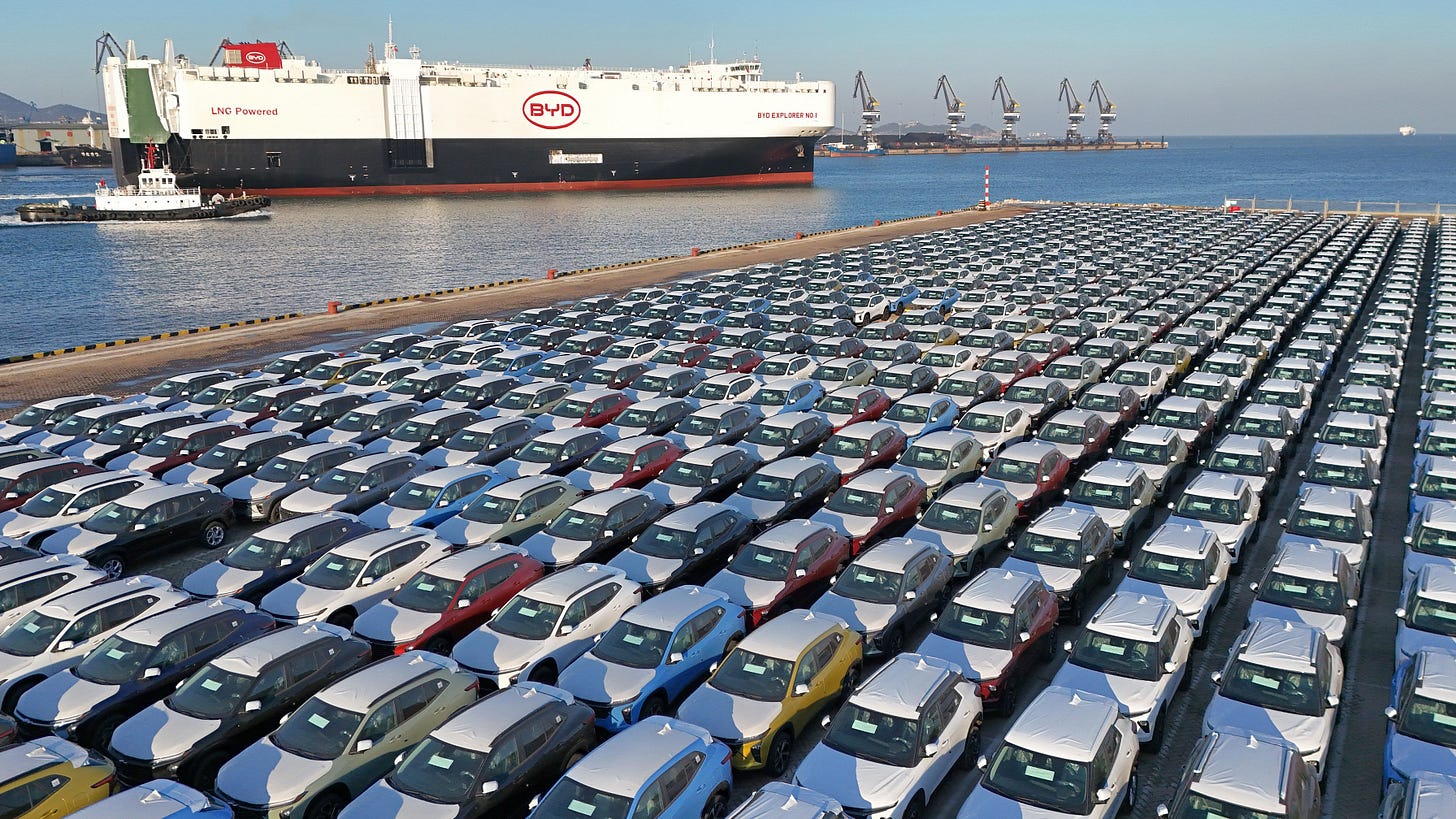EP102: China’s Auto Expansion in Mexico: A Backdoor Threat to North American Trade
The USMCA Loophole: How Chinese Cars Are Flooding Mexico and Beyond
TL;DR:
China is rapidly becoming a dominant player in Mexico's automotive market, leveraging competitive pricing and advanced electric vehicle (EV) technology. This poses economic and strategic risks for the U.S. and Canada under the USMCA trade agreement. Chinese automakers may exploit the agreement's rules of origin by manufacturing in Mexico to avoid tariffs, threatening North American jobs, industries, and supply chains. U.S. and Canadian policymakers are considering stricter enforcement of trade rules, regional collaboration, and potential tariffs to counteract these challenges. Meanwhile, Mexico faces pressure to limit Chinese investments to preserve trade relations within the USMCA framework.
Introduction
China's burgeoning presence in Mexico's automotive market has sparked economic and geopolitical concerns across North America. By capitalizing on Mexico's strategic location, competitive production costs, and access to tariff-free trade under the United States-Mexico-Canada Agreement (USMCA), Chinese automakers are rapidly expanding their foothold in the region. This shift has profound implications for North American industries, as it challenges the balance of trade, threatens domestic manufacturing jobs, and raises questions about compliance with USMCA’s stringent rules of origin.
As Chinese vehicle imports soar, particularly in the electric vehicle (EV) segment, Mexico is becoming a gateway for these products into the U.S. and Canada. This trend not only disrupts the traditional automotive supply chain but also underscores China's broader strategy to penetrate global markets. For North American stakeholders, the stakes are high: unchecked, this expansion could undermine local industries, exacerbate reliance on Chinese supply chains, and weaken the economic integration envisioned by the USMCA.
This article explores the rapid rise of Chinese automakers in Mexico, the potential exploitation of trade loopholes, and the strategic responses needed to address these pressing challenges.
The Problem of China Dumping Automobiles in Mexico and Exploiting the USMCA
China’s growing influence in global automotive markets has raised significant economic and strategic concerns, particularly regarding its burgeoning relationship with Mexico and the implications for the United States-Mexico-Canada Agreement (USMCA). Chinese automakers have made significant strides in exporting vehicles to Mexico, and their increased market penetration raises questions about the potential for tariff circumvention and the broader impact on the North American automotive sector.
The Rise of Chinese Auto Imports in Mexico
China has rapidly emerged as Mexico's leading automotive supplier. In 2023, the value of vehicle imports from China reached $4.6 billion, surpassing the $4.4 billion imported from the United States. This milestone marks a significant shift in Mexico’s automotive trade dynamics, with Chinese vehicles now accounting for approximately 20% of the country’s light vehicle market—an increase of 50% from the previous year. By 2024, projections suggest that one out of every three new cars sold in Mexico will be from China, a dramatic rise from just 4% in 2020. This trend has been driven by aggressive marketing, competitive pricing, and a focus on electric vehicles (EVs), where Chinese manufacturers hold a technological edge. Chinese automakers have leveraged Mexico’s strategic geographic location, established automotive infrastructure, and its membership in the USMCA to accelerate exports. For example, the first five months of 2024 saw Chinese vehicle imports rise by 50.8%, while imports from the U.S. declined by 13.9%. This shift illustrates not only the competitiveness of Chinese products but also a recalibration of trade relationships in North America.
Economic and Strategic Implications for the USMCA
China’s growing presence in Mexico raises concerns about potential misuse of the USMCA framework, which allows for tariff-free trade among member countries under specific rules of origin requirements. The Rules of Origin under the United States-Mexico-Canada Agreement (USMCA) are designed to ensure that only goods that genuinely originate in the USMCA countries benefit from the agreement's preferential tariff treatment. Each product has specific rules that define what qualifies as originating. These rules can include that the product must undergo a change in tariff classification from the non-originating materials used to make it. A certain percentage of the product's value must be added within the USMCA region. Typically, this is calculated using methods like the transaction value method or the net cost method, where 60-75% of the vehicle's value must come from the region for automotive goods Specific manufacturing or processing steps must be performed in the region to meet the requirment. De Minimis rules allows a small percentage of non-originating materials (up to 10% of the value of the good) to be used without affecting the origin status of the product. Components from any USMCA country can be considered originating if further processed or assembled in another USMCA country, promoting regional production chains. Goods or materials of different origins can be interchanged, and their origin can be determined based on methods like first-in, first-out (FIFO) or averaging over a period. Goods must be shipped directly between the USMCA countries, with some allowances for transit through non-USMCA countries under certain conditions to maintain originating status. Exporters or producers must provide a certification of origin, which can be self-certified, detailing how the product meets the rules of origin. This certification is crucial for importers to claim preferential tariff treatment. For vehicles and automotive parts, there are stringent rules, including Labor Value Content (A portion of the vehicle's value must come from high-wage manufacturing activities within the region) and Steel and Aluminum (70% of the steel and aluminum must be melted and poured in the USMCA region). These rules aim to encourage production within the region, increasing economic integration and supporting local industries, while also addressing issues like labor standards and environmental considerations more than its predecessor, NAFTA. However, the complexity of these rules can sometimes pose challenges for businesses in terms of compliance and cost.
By establishing manufacturing plants or relying on assembly facilities in Mexico, Chinese automakers may aim to qualify their products as Mexican-made, thereby circumventing tariffs that would otherwise apply to goods imported directly from China into the U.S. or Canada.
Economic Impact on North American Industries:
The influx of lower-cost Chinese vehicles, particularly EVs, poses a significant challenge to domestic automakers in the U.S. and Canada. These countries are heavily investing in transitioning their automotive industries to EV production, but the competitive pricing and technological advancements of Chinese models threaten to undercut local producers. This could lead to job losses, reduced domestic production, and diminished market share for North American manufacturers.
Geopolitical Concerns and Supply Chain Risks:
The expansion of Chinese manufacturing in Mexico could also exacerbate North American reliance on Chinese supply chains, particularly for EV batteries and critical components. This dependency runs counter to efforts by the U.S. and Canada to diversify supply chains and reduce reliance on China for strategically important goods.
USMCA Compliance and Safeguards:
The USMCA's rules of origin mandate that 75% of a vehicle's content must originate in North America to qualify for tariff-free trade. While this provision aims to protect North American industries, Chinese manufacturers may exploit loopholes by sourcing parts locally or assembling vehicles in Mexico. Such practices, if unchecked, could erode the benefits intended for U.S. and Canadian producers under the agreement.
Strategic Advantages for China
China’s automotive strategy in Mexico aligns with its broader goals of global market penetration and economic expansion. By leveraging Mexico's lower production costs and proximity to the U.S., Chinese automakers gain access to the lucrative North American market while avoiding direct scrutiny. Establishing a manufacturing presence in Mexico also allows Chinese firms to learn and adapt to North American consumer preferences, regulatory requirements, and labor practices.
Chinese companies such as JAC Motors already operate assembly plants in Mexico, and others, including BYD, Chery, and SAIC Motor, are exploring or planning investments in the region. These developments could further integrate Chinese products into North American supply chains, complicating efforts to enforce USMCA compliance.
Potential Responses and Policy Considerations
The U.S. and Canada face a complex challenge in addressing the economic and strategic risks posed by China’s automotive expansion in Mexico. A multifaceted approach is necessary to ensure that the USMCA's benefits are preserved while fostering healthy competition and innovation in the region.
Strengthening Trade Enforcement:
Both countries must bolster enforcement of USMCA rules of origin to prevent tariff circumvention. This may involve stricter audits of automotive supply chains and increased scrutiny of vehicles imported from Mexico with significant Chinese content.
Promoting Regional Integration:
To counteract China’s growing influence, the U.S. and Canada must work with Mexico to strengthen regional automotive production and invest in joint EV manufacturing initiatives. Such collaboration would enhance North American competitiveness while reducing reliance on Chinese imports.
Enhancing Consumer and Safety Standards:
Raising awareness about the quality, safety, and environmental standards of North American-made vehicles could help mitigate the appeal of cheaper Chinese imports. Public campaigns highlighting the benefits of supporting local industries may also influence consumer behavior.
Adapting Tariff Structures:
Should Chinese manufacturers continue to exploit Mexico as a backdoor to the U.S. and Canadian markets, policymakers might consider targeted tariffs or trade adjustments to level the playing field.
Mexico’s Response:
Mexican President Claudia Sheinbaum has acknowledged Canadian concerns about Chinese automotive plants in Mexico but stated that no such plant currently exists. She emphasized that Canada's Prime Minister Justin Trudeau explicitly mentioned not supporting Mexico's exclusion from the USMCA over this issue. However, she also noted the importance of substituting Chinese imports with locally or North American-made products to maintain trade relations. Mexico has been cautious about increasing Chinese automotive presence due to U.S. and Canadian pressures. There's an apparent strategy to shift away from importing Chinese automotive parts, aiming to produce more within Mexico or with North American partners to navigate potential trade conflicts. Reports suggest that Mexico has put a halt to federal incentives for Chinese automakers looking to establish plants, largely due to recent U.S. pressure. This was seen as a move to prevent Mexico from being used as a "back door" for Chinese products into the North American market
American Industry and Advocacy Group Response:
The automotive industry, represented by groups like the Alliance for American Manufacturing, has warned that the presence of Chinese EVs in Mexico could pose an "extinction-level event" for U.S. automakers if not addressed. They argue that without stringent measures, these vehicles could flood the U.S. market at lower prices, undercutting domestic production.
As it looks like that is potential for a large issue of back door dumping was averted provided that Mexico sticks to its word and perhaps is nothing to continue to worry about but simply monitor, it is a good example of how crafty the Chinese are and how innovative and flexible their mindset is in that they are perfectly willing to work within the existing legal framework to corrupt the spirit of the USMCA. It would do the US well to not only monitor Chinese investment in Mexico but also in Canada so this potential abuse of the spirit of the USMCA doesn’t become reality.
Conclusion
China’s rise as Mexico’s top auto importer represents a significant shift in North American trade dynamics with far-reaching implications for the USMCA and regional industries. While the growth of Chinese automotive exports highlights the competitiveness and appeal of their products, it also underscores the need for vigilant trade enforcement and strategic collaboration among USMCA members. By addressing these challenges proactively, the U.S., Canada, and Mexico can safeguard their economic interests while fostering a balanced and competitive automotive market in North America. Donald Trump, during his campaign and after his election in 2024, has used the topic to rally support, claiming that he would prevent Chinese plants in Mexico from harming American jobs.
Sources:
https://www.marklines.com/en/report/rep2667_202405
https://www.wired.com/story/china-conquers-mexican-automotive-market-and-the-us-is-worried/
https://mikekalil.com/blog/china-mexico-automotive-plants/
https://www.motortrend.com/news/report-mexico-halts-federal-incentives-to-chinese-automakers/
https://apnews.com/article/mexico-canada-trade-china-autos-818cd6332cae35d2d7b7eed2975daa20









